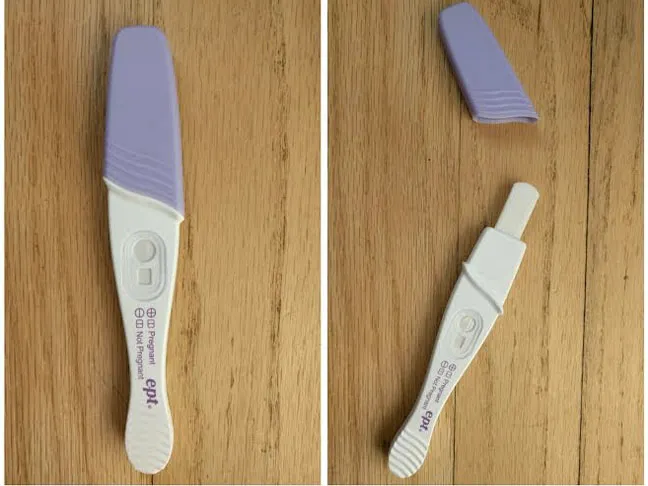When my husband and I were trying to conceive, waiting to use a home pregnancy test was like being locked in a roomful of chocolate truffles after swearing off chocolate. At lunchtime. It was nearly impossible to resist taking the test as soon as I brought it home from the drugstore. But, there’s a process to getting accurate results. Yes, there are new high-tech options like the First Response Pregnancy Pro, which syncs with your Smartphone to compile all of your fertility, ovulation, and test results in one place, but all home pregnancy tests come down to the same thing: peeing on a stick the right way, at the right time. Make sure you get the peeing part right with our step-by-step guide on how to take a pregnancy test, complete with tips from an ob-gyn and fertility expert.
How do pregnancy tests work?
When you’re pregnant, your body produces a hormone called human chorionic gonadotropin (HCG), which is evident in your urine. “Home pregnancy tests contain an indicator chemical that changes color when the antibodies in the test bind to the specific HCG hormone,” says Allison Rodgers, MD, a board certified ob-gyn and fertility expert with Fertility Centers of Illinois, in Chicago.
When should I take a pregnancy test?
Though you may be chomping at the bit to take a pregnancy test (as most of us are!), it’s important to get the timing right to help ensure that the results are accurate. Dr. Rodgers suggests waiting to take it until about a week after you’ve missed your period, once the HCG hormone levels have built up in your system (if you’re pregnant). It’s also best to take the test first thing in the morning when your pee is most concentrated and the hormone is most easily detectable.
How do I take a pregnancy test the right way?
Carefully read the instructions before you take a pregnancy test. Then, follow these steps:
Remove the applicator cap. Keep it close by, because you’ll need it for step #3.
Step 2. Place the fuzzy end of the stick under your urine stream for at least five seconds. Angle the stick toward the toilet, directly below your stream — not inside your vagina. Count slowly (that’s 1-Mississippi, 2-Mississippi, 3-Mississippi…). If the test you purchased requires that the test strip be placed in a cup of pee for best results, then pee directly into a clean cup. Once you’re finished, dip the test strip and hold for the time indicated in the directions.
Step 3. Replace the applicator cap (to reduce mess!) and wait. Lay the test window side-up on a flat surface for two minutes (depending on test instructions).
Step 4. Read the results. A plus sign (+) means pregnant and a negative sign (-) means not pregnant. Other tests actually say pregnant or not pregnant. For help with deciphering your test results, check the instructions that came with it.
Pregnancy test tips:
- Wait to take a test until about a week after your missed period. Yes, some kits boast results as early as five days before your missed period, but Dr. Rodgers says those tests are more likely to be inaccurate. As hard as it is to wait, try — you want an accurate result, right?
- Take the pregnancy test first thing in the morning. Your pee is more concentrated in the morning than at night, so that’s when the results will be most accurate.
- Make sure your test works. Many home pregnancy test sticks feature two small windows. One tells you whether you’re pregnant and the other is there as a control. If nothing appears in the control window, your test may be defective.
- If you see only a faint line, retake the test in a few days. It may mean that the test is faulty, says Dr. Rodgers, or perhaps it’s just very early in the pregnancy (if the result is positive). Once you retake the test you should have a more definitive result.
- A positive test, followed by a negative one, may indicate a chemical pregnancy, which is a miscarriage at 3- to 4-weeks-pregnant when it is too early to see anything on an ultrasound,” says Dr. Rodgers.
If you got the positive result you were hoping for, congratulations! The next thing to do is contact your healthcare provider. Some (like mine) may not want to see you until you are 8- to 10-weeks-pregnant. Until then, rest, take your prenatal vitamin, and follow a pregnancy-safe diet.
More Helpful Stuff:
- 11 Early Signs of Pregnancy You’ve Never Heard Before
- 9 Surprising Fertility Truths & Myths
- 7 Best Sex Positions for Conception
